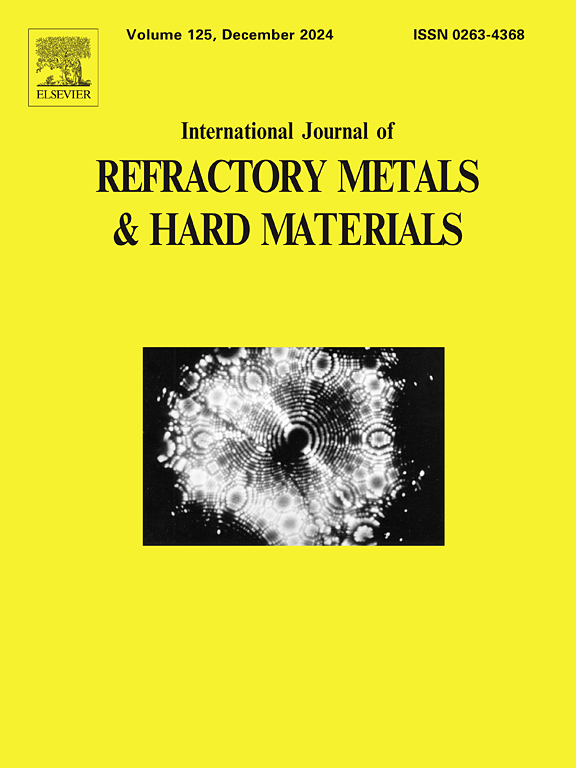CVD Al2O3/Ti(C,N)涂层硬质合金刀具车削不锈钢初期缺口磨损研究
IF 4.2
2区 材料科学
Q2 MATERIALS SCIENCE, MULTIDISCIPLINARY
International Journal of Refractory Metals & Hard Materials
Pub Date : 2025-02-22
DOI:10.1016/j.ijrmhm.2025.107116
引用次数: 0
摘要
在加工不锈钢时,缺口磨损往往决定刀具寿命。化学气相沉积(CVD) Al2O3/Ti(C,N)涂层硬质合金刀具是不锈钢车削的首选工具。CVD涂层在减少和延缓刀具磨损过程中起着至关重要的作用。因此,有必要了解缺口磨损的开始和涂层退化之间的相互作用。然而,大多数出版物都集中在研究缺口磨损的进展,而不是缺口的开始。因此,这项工作研究了两种根本不同的氧化铝基CVD涂层的初始缺口磨损。第一个涂层体系由κ-Al2O3多层层组成,由薄TiN层隔开。第二涂层体系为织构(0001)α-Al2O3固体层。两种涂层都有Ti(C,N)底层。涂层WC-Co刀具在AISI 316Ti中进行了0.3至16 m的面车削评估。结果表明:α-Al2O3/Ti(C,N)多层涂层刀具在接触长度0.3 m (0.3 s)处开始出现缺口磨损;α-Al2O3/Ti(C,N)织构涂层刀具在接触长度1 m (1 s)处开始出现缺口磨损;磨损痕迹表明,在切割的第一个厘米之后,缺口区域已经存在大量的机械和/或热负荷的迹象。最初的缺口磨损是涂层脆性断裂。工具上附着的不锈钢表明附着导致了最初的缺口磨损。本工作的结果促进了对cvd涂层刀具在不锈钢车削中形成缺口的基本机制的更好理解和问题的制定。本文章由计算机程序翻译,如有差异,请以英文原文为准。
Study of initial notch wear during turning of stainless steel with CVD Al2O3/Ti(C,N) coated cemented carbide tools
Notch wear often determines tool life when machining stainless steel. Chemical Vapour Deposited (CVD) Al2O3/Ti(C,N) coated cemented carbide tools are the first recommendation for turning of stainless steel. The CVD coating plays a vital role in reducing and delaying tool wear progress. Hence, it is essential to understand the interaction between the initiation of notch wear and the coating degradation. However, most publications have focused on studying the progression of notch wear rather than the initiation of notch. Thus, this work investigates the initial notch wear in two fundamentally different alumina-based CVD coatings. The first coating system is composed of κ-Al2O3 multilayers separated by thin TiN layers. The second coating system is a solid layer of textured (0001) α-Al2O3. Both coatings have a Ti(C,N) underlayer. The coated WC-Co cutting tools were assessed from 0.3 to 16 m of face turning in AISI 316Ti. The results showed that the notch wear started already at 0.3 m (equal to 0.3 s) of engagement length in the multilayer κ-Al2O3-TiN/Ti(C,N) coated tool and at 1 m (1 s) in the textured α-Al2O3/Ti(C,N) coated tool. The wear marks show signs of substantial mechanical and/or thermal loads in the notch region already after the first centimetres in cut. The initial notch wear occurred as a coating brittle fracture. Adhered stainless steel on the tools suggests that adhesion contributed to initial notch wear. The results of this work promote a better understanding and problem formulation of the fundamental mechanism of notch wear formation when using CVD-coated tools in stainless steel turning.
求助全文
通过发布文献求助,成功后即可免费获取论文全文。
去求助
来源期刊
CiteScore
7.00
自引率
13.90%
发文量
236
审稿时长
35 days
期刊介绍:
The International Journal of Refractory Metals and Hard Materials (IJRMHM) publishes original research articles concerned with all aspects of refractory metals and hard materials. Refractory metals are defined as metals with melting points higher than 1800 °C. These are tungsten, molybdenum, chromium, tantalum, niobium, hafnium, and rhenium, as well as many compounds and alloys based thereupon. Hard materials that are included in the scope of this journal are defined as materials with hardness values higher than 1000 kg/mm2, primarily intended for applications as manufacturing tools or wear resistant components in mechanical systems. Thus they encompass carbides, nitrides and borides of metals, and related compounds. A special focus of this journal is put on the family of hardmetals, which is also known as cemented tungsten carbide, and cermets which are based on titanium carbide and carbonitrides with or without a metal binder. Ceramics and superhard materials including diamond and cubic boron nitride may also be accepted provided the subject material is presented as hard materials as defined above.

 求助内容:
求助内容: 应助结果提醒方式:
应助结果提醒方式:


